Think you have a revolutionary micro-SaaS idea that you think is profitable, but you’re unsure about it?
Remember, turning your idea into a reality will require time and resources—and you don’t want to see it fail.
So, instead of blindly trusting your intuition, you have to validate your idea first.
This post is a complete guide that teaches you how to validate your micro-SaaS idea.
We’ll also give you a step-by-step approach to verifying your startup ideas so that you know whether the idea is worth pursuing or not.
Let’s begin.
Why Should You Validate Your Micro SaaS Idea?
Just because it has the word “micro” doesn’t mean your idea is a less risky venture.
On the contrary, you must take each step in the micro-SaaS validation process seriously so that you can:
1. Save time and resources
Being in the micro-SaaS business means you have to invest considerable time and resources into creating and launching your software product.
This can take anywhere from months to years, so if you don’t verify the idea first and the product turns out to be a failure, chances are high that it’ll all be a waste.
That’s why the validation process is vital before you pursue product development.
2. Ensure that the solution you create has a sustainable demand
Verifying your idea helps you understand the demand for your micro-SaaS product.
Ideally, the problem should be an ongoing, pressing challenge so that you can earn recurring revenue from your solution for a long time.
It will also help you figure out your potential audience size.
After all, you don’t want to invest in creating a product with an audience size of less than a hundred people.
Before you validate your idea, however, you have to evaluate it first.
Idea Evaluation vs. Idea Validation for Micro-SaaS
Idea validation is confirming if people are interested in your idea by testing it live, while evaluation is figuring out an idea’s potential by running it through several criteria.
By evaluating an idea, you’re making estimates based on your research. Since you don’t have a product to test yet, you need to analyze the current market conditions and available solutions to figure out the following:
- What is the problem? Is it big enough?
- What is the audience doing to solve it? What solutions are they relying on?
- Are the existing solutions good enough?
- Is your solution really needed?
- Does it stand out?
- How will your solution perform in the market?
- How many people will be interested in it?
Note that idea evaluation is just a speculation based on your research, and it doesn’t necessarily mean you’ve already validated it.
Again, to verify an idea means you have to test it live. You can determine a product’s performance only after you test it with a real audience.
Both are essential for success, but evaluation must always come first.
Step-by-Step Micro-SaaS Idea Validation Process
Verifying a micro-SaaS product involves two stages:
- Evaluation
- Validation
Below, the first three steps will help you evaluate an idea, and in the next four steps, you will learn how to validate it.
1. Find the market size
First, find out the exact number of your potential customers.
Don’t build something that only a few people need.
On the contrary, your audience size should be considerable enough to build a sustainable business.
You can use any reliable keyword research tool to determine the exact audience size. For our example, let’s use Semrush.
Suppose my product is an email marketing tool; Semrush shows the monthly search volume is 8.3k.
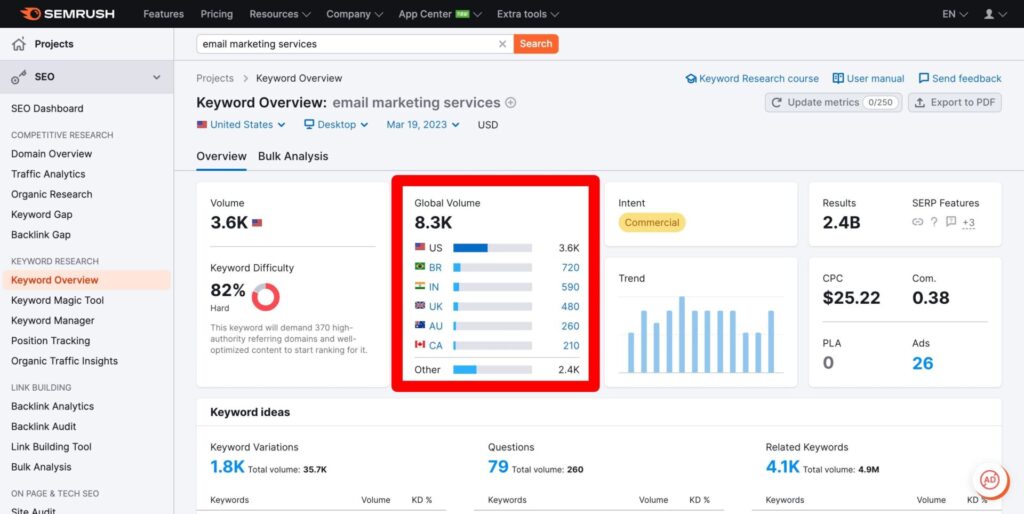
This means that if I launch an email marketing software, there’s a chance 8.3k people will check out my tool every month.
But of course, email marketing is a competitive topic. Not only that, but there are already great solutions, so I won’t get that big share.
In such a competitive market, I’d need to stand out to survive.
One way to do this is by building a solution that offers distinct features and bridges the gaps in the market.
After you’ve gotten the potential numbers, confirm if your product will remain in demand. You can check this through Google Trends.
Ideally, your idea should be something that would remain consistent or trend upwards.
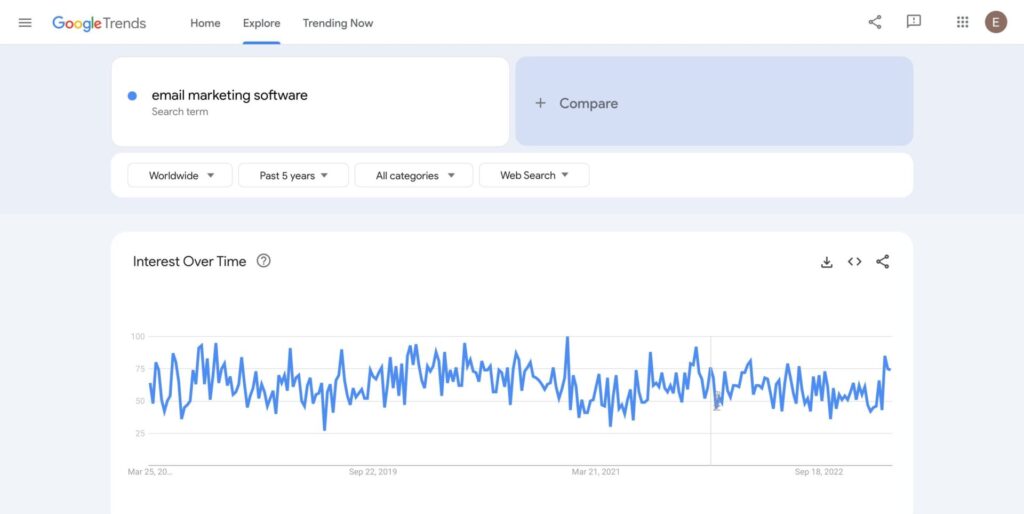
And as you can see, there’s been a consistent demand for email marketing software over the past five years.
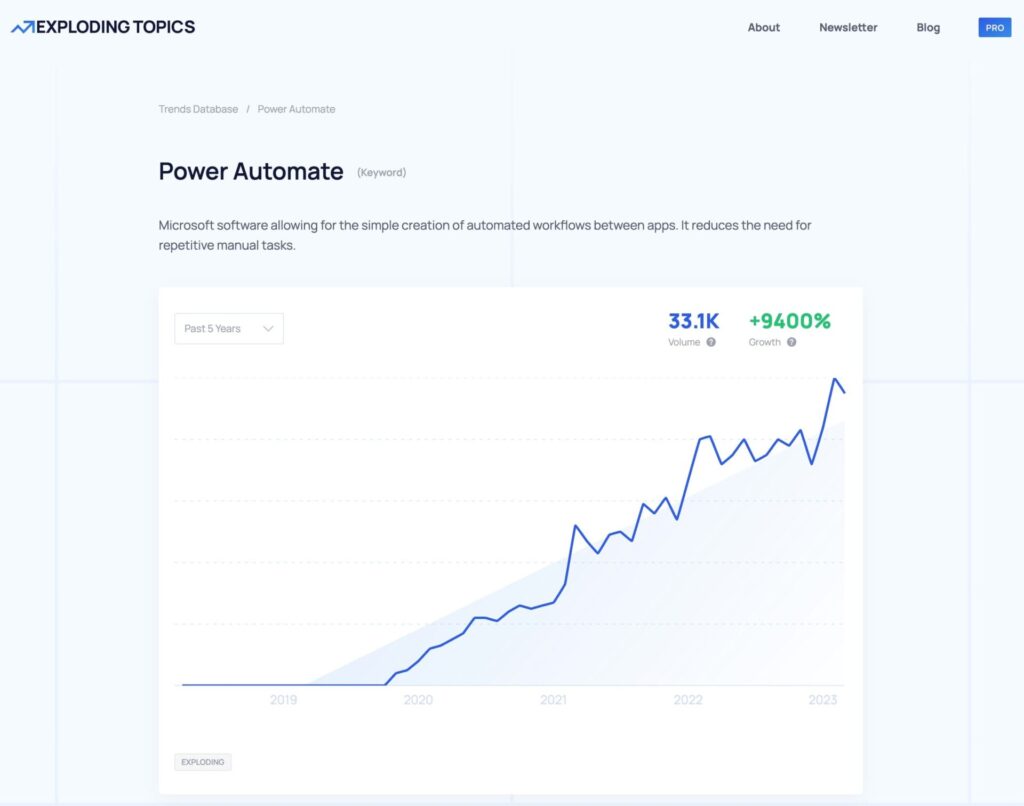
You can also check out Exploding Topics, which predicts new trends in the next few years.
Another tool you can use to discover new ideas or different angles you might have missed is AnswerThePublic.
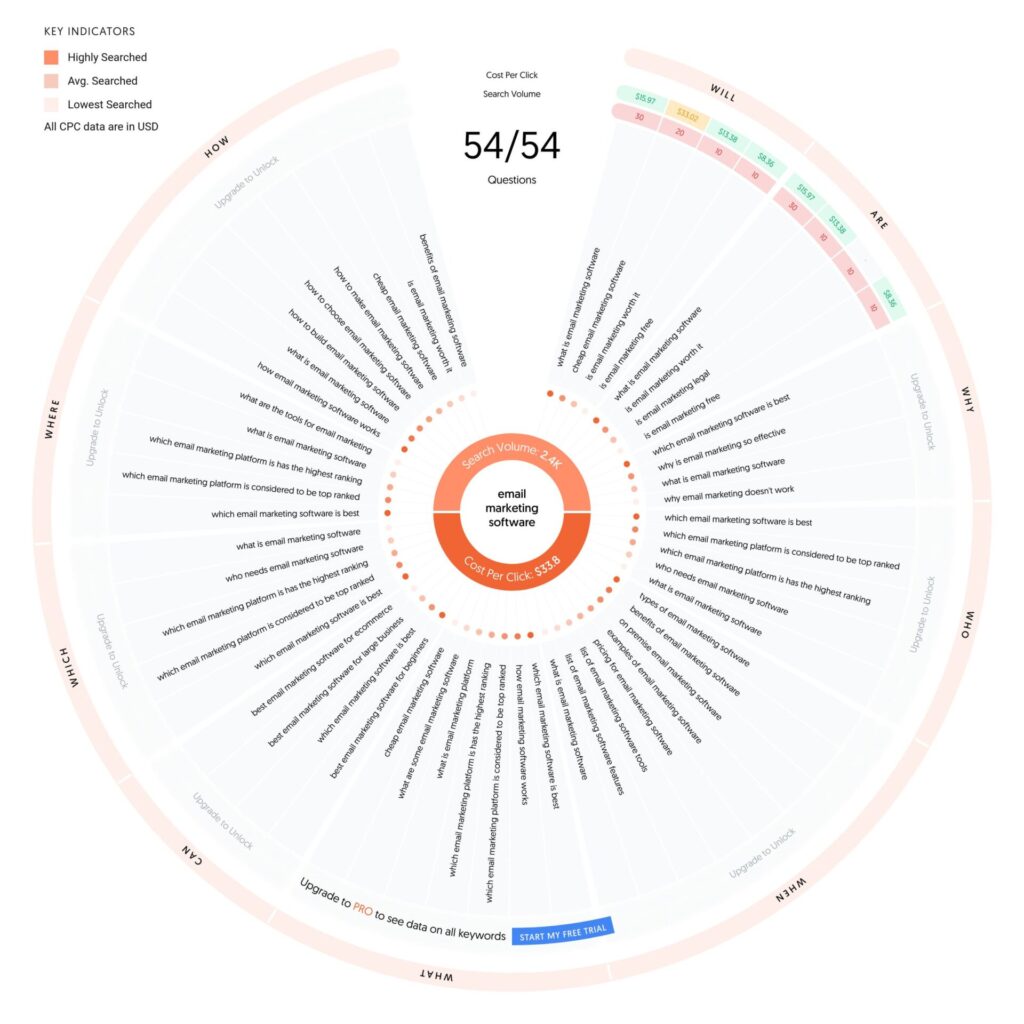
It lists down all the things people are searching for about your keyword idea.
2. Find direct competitors and understand the users’ behavior with these products
Now that you’ve determined that your micro-SaaS idea has a good potential market size, it’s time to analyze the existing solutions.
Ideally, you want to be in a field with a significant market size and no competition. However, such a thing doesn’t exist.
Take our email marketing software example from above.
You already know many established email marketing software exist, so why would anyone need mine, right?
I’ll have to stand out and deliver a unique value that others won’t, which is exactly what Convertkit did.
Convertkit found that existing solutions like Mailchimp were created for businesses with big teams. This left a big chunk of the audience—solopreneurs—uncatered.
Convertkit targeted these creators (a one-person team) and stood out from the rest.
To find gaps in the market, like ConvertKit did, you have to analyze existing solutions and discover the problems users face when using them.
You can analyze these gaps by reading user comments on Chrome Web Store or App Store.
Look for comments with negative ratings; they will tell you the experience users had.
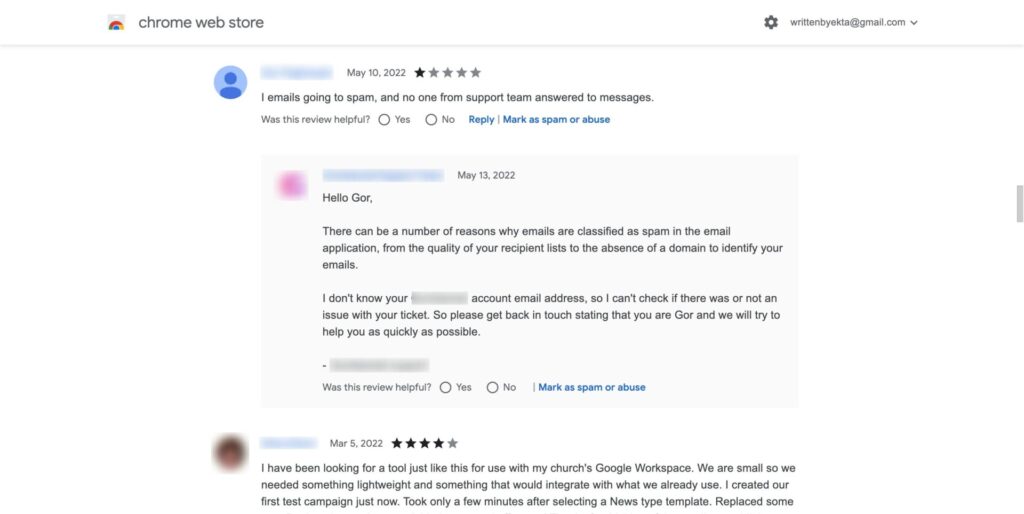
Other places to check out include Quora threads, Subreddits on Reddit, Facebook Groups, Slack groups, or any online community where your target audience hangs out.
People discuss their problems with others in these communities. Your job is to be active and read these conversations.
You can take it further by reaching out to people with problems and trying to figure out their pain points.
Try to show genuine concern and understand their struggles. This way, people will likely be open to conversation.
3. Conduct surveys to collect data
After you’ve talked to enough people and understood their real pain points, you’ll likely realize that your initial idea wasn’t a great solution either.
Now is, therefore, a good time to nail down on your product ideas.
Once you’ve created a better offer, create a survey form to collect more responses.
Your goal here is to verify the insights you gained from the above step.
You can create a TypeForm and share it across social media or leverage paid ads to get more responses.
Once you’ve gathered enough replies, you can schedule a call with them.
In this call, you should expand on your research from before. Talk to potential users and figure out the following:
- What are their pain points, struggles, and problems?
- How are they addressing these problems?
- What tools are they using to fix it?
- Is the tool helping them?
- What’s their feedback on the current tool?
- What are their suggestions?
Don’t forget to pitch your product idea and ask if they’d be willing to use it. If they say no, what would encourage them to use your software?
4. Create a pre-launch landing page
By now, you probably have enough data to create a better solution than what’s currently out there.
However, you shouldn’t be entirely sure yet. After all, you can only confirm your idea after testing it with a live audience.
That said, now is the time to validate your product.
And one way to do that is by pre-selling your idea to test the waters with minimal effort.
By pre-selling, this means selling your idea even when you haven’t started the product yet.
Instead of pursuing product development right away, what you have to do is create a pre-launch landing page where you’ll send direct traffic and track conversions to understand user behavior.
If people join the waitlist, it’s a good sign that they are interested.
On the other hand, if you don’t get any sign-ups even after trying every marketing technique, take it as a signal to stop working on that idea or improve it.
5. Create an MVP version of your product
Another way—although it requires some work—is to test a mini version of your product with an audience to verify your idea for software.
What this means is that you’ll create the MVP version of your product that focuses on one problem you’re solving.
Go through the data you collected and find one big problem, look for its solution, and develop a basic version that solves it.
6. Beta-test your product
After your MVP is ready, it’s time to test it with a real audience. You have two ways (free and paid) to test it, depending on how you want to do it.
If you’re OK with launching your product for free, you can get it published on the Chrome Web Store and make it available for everyone.
But if you want to test if people will invest in your tool, have a pricing plan in place.
It can be a tiny fee they have to pay to try your tool.
To do this, you can reach out to some of your test subjects in the past steps and offer them a special discount as a thank you.
You can also opt to publish it on the Chrome Web Store as a freemium plugin if that’s more amenable to you.
The important thing is to get as many people to test your tool as possible.
If you’re getting many test subjects, take it as a signal that your idea is viable.
7. Receive feedback
Once you’ve done plenty of beta-testing, try to schedule calls with each beta-tester and ask for feedback on how their experience was.
Include questions like:
- How was your overall experience with the product?
- What did you like the most?
- What did you like the least?
- What’s one thing that you think can be improved?
- What do you think should be included?
- Would you replace your current tool with this?
You can then improve your tool based on the answers you get.
Make sure to include the features they mentioned and get your final product ready for the big day.
Once you’ve launched it, focus on getting your first paying clients and serving them well.
Note, however, that your job doesn’t end here. Contrary to popular belief, you need to keep receiving feedback to continuously improve your product.
FAQs on Validation for Micro-SaaS Ideas
How do you validate a micro-SaaS idea?
The best way to validate your idea before investing in it is by beta-testing it with a real audience.
Create an MVP version of your product and launch it for public use. Take note of their behavior towards your software and use their feedback to improve it.
What is an MVP?
MVP stands for “minimal viable product”. It’s the most basic form of your idea and has only one distinct feature that solves the specific problem you set out to resolve for your target users.
Final Thoughts on How to Validate a Micro-SaaS Idea
It’s better to be backed up with data from experiments than rely on intuition or educated guesses when starting a micro-SaaS business.
Following this step-by-step guide, you should be able to validate your product already. Once done, the next step is to turn it into a successful micro-SaaS business.
Here’s a video to help illustrate the validation steps for micro-SaaS:
I made sure to simplify the steps as much as possible, but if it is still confusing, we’re here to help.
Symalite Labs helps aspiring SaaS founders launch successful businesses—from start to launch—so that they feel confident about their ideas.
Schedule a free call with us to discuss your business ideas and turn them into successful SaaS apps.
In the meantime, you may want to head over to Group Leads or Chatsilo to check out the kind of work we’ve done in the past.

